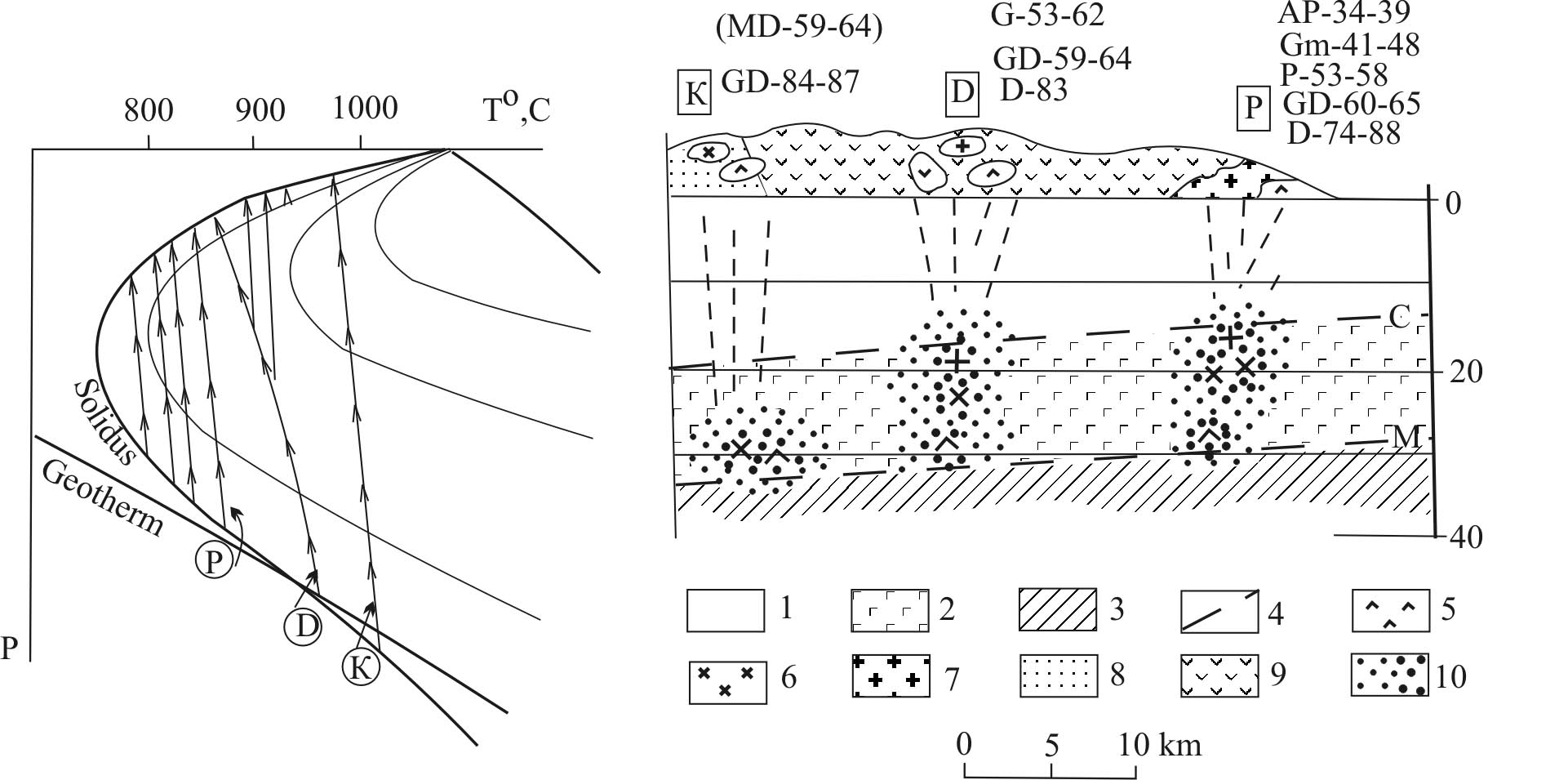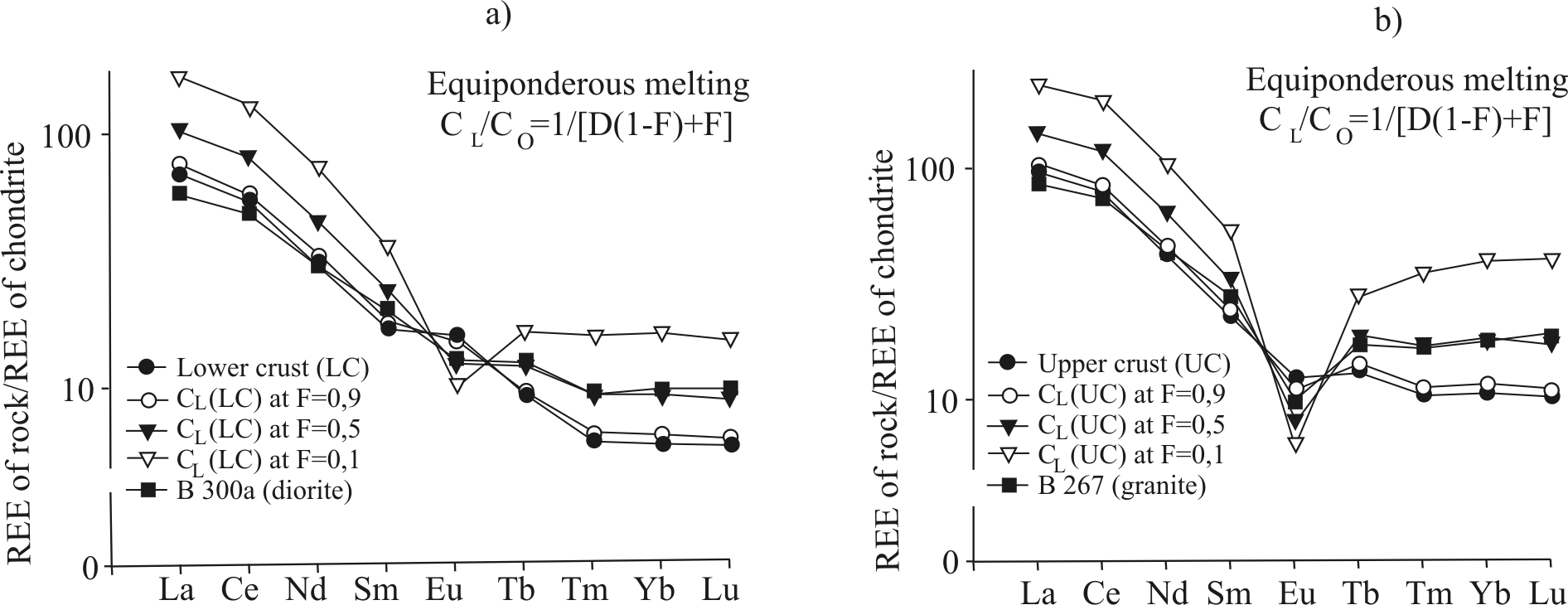|
CONDITIONS OF GRANITOID GENERATION AND CRYSTALLIZATION IN THE EAST-SIKHOTE-ALIN VOLCANIC BELT Far East Geological Institute FEB RAS, Vladivostok, Russia, gvalui@mail.ru
According to the ideas of modern researchers, granite melts are fused from the crust rocks and preserve some geochemical characteristics of the original rocks. Considering the geochemical features of granitoids allows us to approach a solution of the problem of the granite magma generation conditions. In this regard the study of granitoids of the East Sikhote-Alin volcanic belt (ESAVB), situated on the continent-ocean boundary, gets of great significance for understanding the processes of melt fusion in the transition zone.
Fig.1. On the left – scheme of the magmatic process development in the water-bearing crust and upper mantle according to the decompression model (Kadick, Frenkel, 1982). Variants of decompression: K – melts of intrusives of the Krasnorechensk uplift, D – Dal’negorsk VTS, P – Coastal zone. On the right - schematic section across the strike of the East-Sikhote-Alin volcanic belt. The structure of the earth's crust in the continent-ocean transition zone - after V.L. Bezverkhny (1981), the depth of magmatic centers by petrological data. Letters: С - Coastal zone, D -Dalnegorsk volcanostructure, К - Krasnorechensk uplift. 1 -granite layer, 2 - basaltic one, 3 - mantle, 4 - Mokho (M) and Konrad (K) boundary, 5 - diorites (D) and monzodiorites (MD), 6 -granodiorites (GD), 7 - granite (G), miarolic, alkaline, aplite-like ones (Gm), S - rocks of Taukha terrane, 9-rocks of volcanic belt, 10 - suggested place of melt generation. Figures - age of intrusive formations (m.y.), potassium-argon method, laboratories of the Far East Geological Institute and Primorskaya Geological Administartion (Vladivostok), in brackets - laboratory of Siberian Geochemical Institute (Irkutsk). Intrusives of the eastern part (the Japanese Sea coast – group 1) form large (tens kilometers) many-phase bodies composed by equigranular rocks of the diorite-granodiorite-granite composition. They were crystallized at 650-750oC and were magnetitic. Massifs of the western part of the belt (the Dal’negorsk district - group 2 and the Krasnorechensk uplift - group 3) are one-phase and composed by distinctly porphyry-like rocks belonging to the ilmenite series. They were crystallized at 750-850oC and 800-900oC, correspondingly. They form small bodies (first kilometers in the Dal’negorsk district and tens meters in the Krasnorechensk rise), are accompanied by boron-silicate and polymetallic deposits in the Dal’negorsk district and tin-polymetallic ones in the Krasnorechensk uplift, whereas only insignificant magnetite-skarn and molybdenum occurrences were found in the intrusives of the coastal group. It was established that the intrusives of group 1 were formed from the lower-temperature melts that contained less then 3 mass % H2O and were melted at lesser depths (12-15 km) than those of group 2 massifs that were developed from higher-temperature melts with the initial water content more than 3 mass % H2O at depth of 18-20 km (Dal’negorsk volcanic structure) and 25-30 km (Krasnorechensk rise). This difference is likely to be caused by deepening the magmatic chambers from coast to continent. Dynamics of melt migration and separation of fluids was different for the intrusives of the three groups. Magmatic masses of group 1 intrusives ascended with some cooling, reaching the degassing conditions only near the solidus that decreases significantly their ore-generating abilities. More deeply seated and higher-temperature melts of groups 2 and 3 ascended to the surface without essential heat exchange and lost the fluid phase at the ascent early stages with reaching the solidus that provided their high ore-generating abilities (Fig. 1).
Fig. 2. Model distribution of REE through melting of rocks of the lower and upper crust (after Weaver and Tarney, 1984) and comparison with diorite (sample B300 a) and granite (sample B267) of the Oprichninsky massif. CL – concentration of an element in the being formed (or residual) melt at a weight share of the melt F=0.9-0.1. The processes of the original melt differentiation at different levels and stages of the melt existence manifest themselves widely in the granitoid intrusives of the East Sikhote-Alin volcanic belt. Fractional differentiation at the generation level gives rise to rock series, related by cotectic ratios and similar REE distribution, to large many-phase intrusives of the diorite-granodiorite-granite composition in the east and one-phase bodies of gabbro-diorites, granodiorites, and granites in the west ESAVB. They are formed by isolated portions of the differentiated magma. The degree of melt differentiation decreases from east to west synchronously with increase in the earth’s crust thickness. Calculation of the REE model distribution for the rocks of the upper and lower crust, granites and diorites showed that diorites could be originated through the complete equiponderous melting (according to the light REE content) or through the fifty-percent melting+ the lower crust rocks (according to the heavy REE content), and granite melts at the same ratios – through the upper crust melting (Fig. 2). According to the level of REE contents, the diorites of the coast and Krasnorechensk monzodiorites can be considered as original (primary) and granodiorites and granites as fractional (daughter) magmas. References Bezverkhniy V.L. Geological structure and Pre-Quaternary history of shelf development of the Japanese Sea continental slope in the coasts of South-East Primorye. Abstract of thesis prepared by candidate. Vladivostok, 1981. 35p. Kadick A.A., Frenkel M.Ya. Decompression of crust and upper mantle rocks as mechanism of magma formation. Moscow: Nauka, 1982, 120p. Reif F.G. Ore-forming potential of granites and conditions of its realization. Moscow: Nauka, 1990, 180 p. Ustiev E.K. Problems of volcanism-plutonism. Volcano-plutonic formations. Izvestiya AN SSSR (Proceedings of the USSR Acad. Sci.). Geological series. 1963. N 12. P.3-30. Valui G.A. Petrological features of granitoids of the East-Sikhote-Alin volcanic belt. Tikhookeanskaya Geologiya (Pacific Geology), 2004, v. 23, N 3, P.37-51. Weaver B.L., Tarney J. Empirical approach to estimating the composition of the continental crust. Nature, 1984. V. 310, P.575-577.
|

